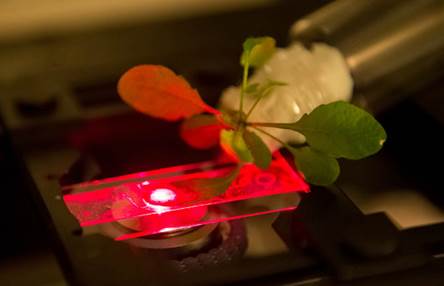纳米技术可以把灌木变为超级能源生产者
来源:《Nature Materials》
作者:Juan Pablo Giraldo等
时间:2014-04-08

Researchers use a near-infrared microscope to read the output of carbon nanotube sensors embedded in an Arabidopsis thaliana plant.
植物有很多有价值的功能:提供食物和燃料、释放我们呼吸的氧气、美化我们的环境。现在,麻省理工学院的一组研究人员想用纳米材料强化植物,扩大其功能:提高能源生产,赋予如监测环境污染物等新功能。在一篇《自然材料》新研究中,研究人员报告,在植物叶绿体中嵌入碳纳米管可以将其捕捉光能量的能力提高30%,叶绿体是植物光合作用发生的场所。他们使用另一类型的碳纳米管改良植物用于检测一氧化氮。
这些表明已经启动研究人员称之为“植物纳米仿生学”科学领域的第一步。
“植物是非常有吸引力的技术平台,”化学工程碳专项P. Dubbs教授与麻省理工学院研究小组Michael Strano说。“他们自我恢复,适应外界环境而稳定,在恶劣的环境中生存,并能自我提供能量源及水分配。”
Strano与该文第一作者、博士后和植物生物学家Juan Pablo Giraldo设想把植物转变成自供能源的光子装置,如探测爆炸物或化学武器等的探测器。研究人员致力于安插电子设备到植物中。“潜力真的无止境,” Strano说。(编译:中国科学院成都生物研究所 王芋华,王海燕)
Plant nanobionics approach to augment photosynthesis and biochemical sensing
Abstract The interface between plant organelles and non-biological nanostructures has the potential to impart organelles with new and enhanced functions. Here, we show that single-walled carbon nanotubes (SWNTs) passively transport and irreversibly localize within the lipid envelope of extracted plant chloroplasts, promote over three times higher photosynthetic activity than that of controls, and enhance maximum electron transport rates. The SWNT–chloroplast assemblies also enable higher rates of leaf electron transport in vivo through a mechanism consistent with augmented photoabsorption. Concentrations of reactive oxygen species inside extracted chloroplasts are significantly suppressed by delivering poly(acrylic acid)–nanoceria or SWNT–nanoceria complexes. Moreover, we show that SWNTs enable near-infrared fluorescence monitoring of nitric oxide both ex vivo and in vivo, thus demonstrating that a plant can be augmented to function as a photonic chemical sensor. Nanobionics engineering of plant function may contribute to the development of biomimetic materials for light-harvesting and biochemical detection with regenerative properties and enhanced efficiency.
原文链接:http://www.nature.com/nmat/journal/vaop/ncurrent/full/nmat3890.html




